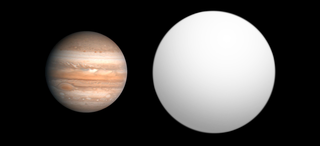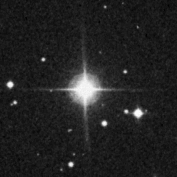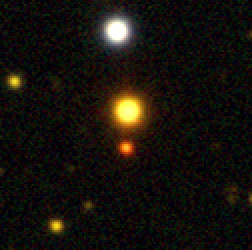
A giant planet, sometimes referred to as a jovian planet, is a diverse type of planet much larger than Earth. Giant planets are usually primarily composed of low-boiling point materials (volatiles), rather than rock or other solid matter, but massive solid planets can also exist. There are four such planets in the Solar System: Jupiter, Saturn, Uranus, and Neptune. Many extrasolar giant planets have been identified.

Brown dwarfs are substellar objects that have more mass than the biggest gas giant planets, but less than the least massive main-sequence stars. Their mass is approximately 13 to 80 times that of Jupiter (MJ)—not big enough to sustain nuclear fusion of ordinary hydrogen (1H) into helium in their cores, but massive enough to emit some light and heat from the fusion of deuterium (2H). The most massive ones can fuse lithium (7Li).

Gliese 229 is a binary system composed of a red dwarf and the first brown dwarf seen by astronomers, 18.8 light years away in the constellation Lepus. The primary component has 58% of the mass of the Sun, 69% of the Sun's radius, and a very low projected rotation velocity of 1 km/s at the stellar equator.

2M1207b is a planetary-mass object orbiting the brown dwarf 2M1207, in the constellation Centaurus, approximately 170 light-years from Earth. It is one of the first candidate exoplanets to be directly observed. It was discovered in April 2004 by the Very Large Telescope (VLT) at the Paranal Observatory in Chile by a team from the European Southern Observatory led by Gaël Chauvin. It is believed to be from 5 to 6 times the mass of Jupiter and may orbit 2M1207 at a distance roughly as far from the brown dwarf as Pluto is from the Sun.

A sub-brown dwarf or planetary-mass brown dwarf is an astronomical object that formed in the same manner as stars and brown dwarfs but that has a planetary mass, therefore by definition below the limiting mass for thermonuclear fusion of deuterium . Some researchers call them rogue planets whereas others call them planetary-mass brown dwarfs. They are sometimes categorized as Y spectral class brown dwarfs.

AB Pictoris is a K-type main-sequence star, located 163.5 light-years away in the southern constellation of Pictor. It has been identified as a member of the young Tucana–Horologium association. The star has been classified as a BY Draconis variable, indicating it has an active chromosphere. It is an X-ray source and displays emission lines in its spectrum.

HD 136118 is a star in the Serpens Caput section of the Serpens constellation. The star is too dim to be readily visible to the naked eye, having an apparent visual magnitude of 6.93. It is located at a distance of 165 light years from the Sun based on parallax, and is drifting closer with a radial velocity of −3 km/s.

109 Piscium b is a long-period extrasolar planet discovered in orbit around 109 Piscium. It is about 5.74 times the mass of Jupiter and is likely to be a gas giant. As is common for long-period planets discovered around other stars, it has an orbital eccentricity greater than that of Jupiter.
Gliese 86 is a K-type main-sequence star approximately 35 light-years away in the constellation of Eridanus. It has been confirmed that a white dwarf orbits the primary star. In 1998 the European Southern Observatory announced that an extrasolar planet was orbiting the star.
A substellar object, sometimes called a substar, is an astronomical object, the mass of which is smaller than the smallest mass at which hydrogen fusion can be sustained. This definition includes brown dwarfs and former stars similar to EF Eridani B, and can also include objects of planetary mass, regardless of their formation mechanism and whether or not they are associated with a primary star.
HD 176051 is a spectroscopic binary star system approximately 49 light years away from Earth in the constellation Lyra. The pair orbit with a period of 22,423 days and an eccentricity of 0.25. Compared to the Sun, they have a somewhat lower proportion of elements more massive than helium. Their individual masses are estimated at 1.07 and 0.71 solar masses (M☉). The system is moving closer to the Sun with a radial velocity of −47 km/s and will reach perihelion in about 269,000 years when it comes within roughly 17 ly (5.1 pc) of the Sun.
HD 190228 is a star with an orbiting substellar companion in the northern constellation of Vulpecula. Its apparent magnitude is 7.30 – too faint to be seen with the naked eye – and the absolute magnitude is 3.34. Based on parallax measurements, it is located at a distance of 205 light-years from the Sun. The system is drifting closer with a radial velocity of −50 km/s.

GJ 3021 b, also known as Gliese 3021 b or HD 1237 b, is an extrasolar planet approximately 57 light-years away, orbiting its bright G-dwarf parent star in the Southern constellation of Hydrus. It was discovered with the Swiss Euler Telescope at the Chilean La Silla Observatory in 2000.

UScoCTIO 108 is a binary system, approximately 470 light-years away in the Upper Scorpius (USco) OB association. The primary, UScoCTIO 108A, with mass around 0.06 solar masses, is a brown dwarf or low-mass red dwarf. The secondary, UScoCTIO 108B, with a mass around the deuterium burning limit of 13 Jupiter masses, would be classified as either a brown dwarf or an extrasolar planet.
Kepler-39b, is a confirmed extrasolar object discovered orbiting the F-type star Kepler-39. It is eighteen times more massive than Jupiter, and is about five fourths its size. The planet orbits its host star at about 15% of the average distance between the Earth and Sun. Kepler-39b's host star was investigated by European astronomers along with three other stars, including the host star of Kepler-40b, using equipment at the Haute-Provence Observatory in France. Collection and analysis of data in late 2010 led to the confirmation of Kepler-39b. The discovery paper was published in a journal on June 6, 2011.

Kappa Andromedae b is a directly imaged substellar object and likely superjovian-mass planet orbiting Kappa Andromedae, a young B9IV star in the Andromeda constellation, about 170 light-years away. The companion's mass is roughly 13 times the mass of Jupiter. As early history on Kappa And b is filled with debate over whether it is an exoplanet or a brown dwarf, some scientists have broadly described it as a "super-Jupiter" object.

V1400 Centauri is a pre-main-sequence star in the constellation Centaurus at a distance of about 451 light-years from Earth. A relatively young star, its age is estimated to be 16 million years, and its mass is about 90% that of the Sun. The star has a maximum apparent magnitude of 12.2 and requires a telescope to be seen. The star's name comes from the SuperWASP program and the star's coordinates.

BD+60 1417b is a confirmed exoplanet discovered in the year 2021 using the imaging method. BD+60 1417b is the only known exoplanet in the system BD+60 1417, around 45 parsecs from Earth. BD+60 1417 is a young K0 star, while BD+60 1417 b has a late-L spectral type. The planet might be the first discovery of a directly imaged exoplanet found by a citizen scientist. Discovery of exoplanets involving amateurs are usually transiting exoplanets and are rarely discovered with other methods. Another example of a non-transiting exoplanet discovery by an amateur is the microlensing exoplanet Kojima-1Lb.












